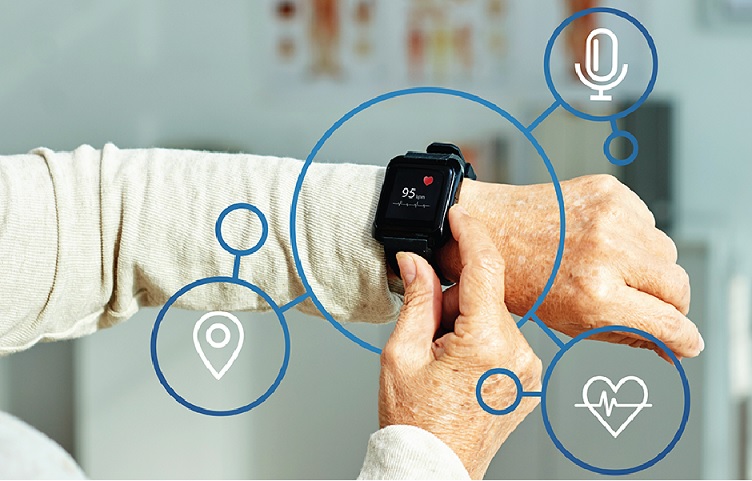
Across the world, people's appetite to track and analyze data on all things relating to their health and wellbeing continues to rise. From physical activity and heart rate to blood pressure and sleep patterns, we increasingly want to monitor and manage a whole host of health-related metrics.
This explains why the market for consumer medical wearables is one of the fastest growing sectors in the technology industry. Recent data showed that the global wearable healthcare market is projected to reach $30.1 billion by 2026 from $16.2 billion in 2021. According to Deloitte, 320 million consumer medical wearables will ship globally in 2022.

Photo from rapidsos.com
At Cisco AppDynamics, we recently conducted research exploring consumer attitudes and behaviors in relation to wearable technology. The results illustrated the scale of consumer demand and expectation in this area — 37% of people say that they are already using at least one wearable technology device and as many as 73% plan to increase their use of wearable technologies and associated applications over the next 12 months.
There is a real excitement about the potential benefits of wearable technology for people's health and wellbeing, and on overall population health, at a time when many healthcare systems are still reeling from the impact of the Covid-19 pandemic. In truth, 85% of people agree that wearable technology has the potential to positively transform both their own personal health and public health services as a whole. Without doubt, the impact of people taking a more proactive approach and greater personal responsibility for their own health and wellbeing can only be a good thing.
Data Security and User Experience Is Key to Building Trust
When it comes to wearable technology, data is key. The devices that people wear capture data and feed this through to the growing number of applications that are now available for people to track, analyze and optimize their health and wellbeing. And in an area such as health, where the information captured can be so personally sensitive, the need for consumers to trust that the brands behind these applications are handling their data in a secure way is absolutely essential.
People want real-time access to accurate health data and they want to be able to share their data with friends and family. This is seen as pivotal for a good user experience. But at the same time, they have zero tolerance for brands that fail to protect the privacy and security of their data.
In our study, 87% of global consumers claimed that trust is a critical factor when choosing a wearable medical device or application brand. And, 86% expect companies offering wearable technology and applications to demonstrate a higher standard of protection for their personal data than any other technology they use.
Evidently, wearable technology and application providers need to ensure they are upholding the highest levels of application security in order to build trust with existing customers and to reassure the wider market.
But it's important to recognize that consumer trust is not only built around data privacy and security. Application providers also need to ensure that they are providing seamless experiences at all times, otherwise they risk seeing customers walk away, never to return. Our research provides a pretty stark warning for digital health application providers about the risks of poor IT performance and availability — that's everything from slow or unresponsive pages, password and login issues or difficulties with downloads and installations.
Consumers simply won't put up with any problems when using wearable technology and digital health applications and they're not willing to give second chances. 75% of people claim that they would stop using a specific wearable device or application if they had a single bad digital experience; and a staggering 56% of people claim that a bad digital experience with one wearable device or application would put them off trying other health or wellbeing wearable technology.
To put that into context, if somebody encounters a problem with a wearable device or digital health application, they won't just decide not to use the brand in question again, it's likely they'll turn their back on all wearable technology going forward.
Of course, after the initial disappointment and frustration (and sometime) has passed, some people would probably be willing to give wearable technology another try, but these findings really do showcase the importance people now attach to digital experience and the strong reactions people are having to poorly performing technology.
Unified Visibility Into IT Performance Is Critical to Meet Customer Expectations and Seize the Opportunity for Wearable Technology
With the pressure growing on digital health application owners to deliver frictionless user experiences at all times, it's essential that they have real-time visibility into IT performance up and down the IT stack, for compute, storage, network and public internet, from the customer-facing application to deep down in the back-end. Full-stack observability is vital for technologists to be able to identify and fix issues before they impact users.
But with so much complexity across an increasingly sprawling IT estate, and IT departments being overwhelmed by a constant deluge of data, technologists need a business lens on IT performance data to cut through the noise and pinpoint the data that really matters most. They need to understand which issues could have the biggest impact on customers so they can prioritize their actions in the right places.
By connecting full-stack observability with real-time business metrics, technologists can optimize application performance at all times and ensure they're able to meet heightened consumer expectations. By doing this, digital health application owners can build trust with customers and set themselves up to take full advantage of the massive opportunities that now exist in the wearable technology market.
